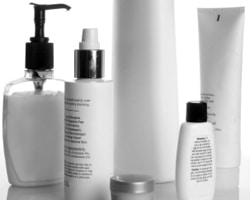
Reading any type of small print is strenuous on the eyes. When it comes to cosmetic and personal care products, it is a good idea to consider reading the label as these purchases are likely used every day. It’s important to understand what is in your skin creams, sunscreens, shampoos and soaps because your skin is your biggest organ and what you put on it gets absorbed into your body.
We are not only what we eat; we are also what we expose our bodies to from the outside!
Most of us think that if a personal care product label says “natural”, it is perfectly safe for us to use. But the fact of the matter is we must be aware of the guidelines surrounding the “natural” label. Foods labeled “natural” cannot contain any artificial ingredients or added colors. As well, products labeled “natural” must be minimally processed. The USDA unfortunately does not provide a definition for what “minimally processed” means and therefore leaves a gray are with respect to labeling.
To learn more about understanding label claims, Click Here.
Read the following tips and become a more educated savvy consumer:
Savvy Tip #1: Educate Yourself
It is our responsibility as consumers to educate ourselves about which ingredients are safe and which are not when it comes to personal care products. Good sources of information include government health websites and reputable health education sources. To learn more about how to get started when it comes to living a more natural and organic lifestyle, Click Here.
Educate yourself when it comes to chemical additives that are commonly used in cosmetics and personal care products. Many chemical additives have been banned in Europe due to scientifically based health concerns. Some chemical additives are now being researched in North America to see what the short-term and long-term affects me to human being, animal and the earth itself.
Read the following list to learn more about the commonly used chemical additives in beauty and personal care products:
Alcohols: Isopropyl alcohol, Ethyly Alcohol, Methanol, Benzyl Alcohol, SD Alcohol and Alcohol Denat.
Parabens: Butly, Ethyl, Methyl and Propyl Parabens
DEA, MEA & TEA: aka. Diethanolamine (DEA), Monoethanolamine, (MEA), Triethanolamine (TEA)
Ureas: Diazolidinyl Urea, Imidazolidinyl Urea
FD&C Colors and Pigments: reds, blue and yellows
Fragrances: aka. Parfum, Natural Fragrance (all are synthetic scents that mimic real scents from nature)
Petroleum: By-Products – mineral oil, liquid and solid paraffin wax, petrolatum, petroleum jelly
Glycols: Polyethylene (PG), propylene (PEG), butylene glycol
Sulphates: all sulphates including SLS (sodium Lauryl Sulphate), SLES (Sodium Laureth Sulphate) and all derivatives
Triclosan: sometimes classified as chlorophenol (used in toxic pestisides and in anti-bacterial products)
Phthalates: all forms
Phosphates: all forms
Savvy Tip #2: Don't Make Assumptions
When reading product claims, be an active reader. When it comes to organic, know what the labels mean. When a product is “Made with Organic Ingredients” it must contain between 70% and 94.9% organic ingredients to qualify for this claim. Be cautious of the percentage that is not organic, which legally must be listed.
Flip the product box around and take a good look at the actual ingredients. Hopefully the ingredients will be in a language you understand. However, some manufacturers legally use botanical or Latin names for ingredients, which makes it even harder to decipher for everyday consumers. If you see ingredients listed that you don’t recognize as real- such as hydrogenated oils, alcohols, sulphates-write the ingredient names down and research what they are when you get home. Or Click Here to ask the Naturally Savvy Experts. After all, you deserve to know what you are putting on your body.
Savvy Tip #3: Put that Bottle Down
Consider ingredients that are more natural, meaning did it come from the earth? These would be more "real" than manufactured ingredients, which could even be toxic to us. If you don't see "real" ingredients then put that bottle down. So much of what we use today is not very "real", from the food we eat to the clothes we wear. Be choosy with what you buy and look for companies that offer chemical-free or at least 98% natural ingredients in their products.
The good news is there are many excellent companies whose products are made from "real" ingredients, sometimes even by hand using traditional methods, and are practical and affordable. For tips on how to shop naturally and organically without breaking the bank, Click Here.
Savvy Tip #4: Get Back to Basics
The fact of the matter is we don't need all those chemical additives to take care of our skin and hair despite claims made by manufacturers. Many of these ingredients are utilized because they make it cheaper for manufacturers to create large quantities of products while using very little real ingredients. You are far better off with products that have a few basic ingredients when washing your hair or applying lotion to dry skin.
Below is list of some "real" and trusted ingredients that are exceptionally good for our skin and hair. Look for companies that use these ingredients next time you are shopping for a natural cream, cleaner or conditioner. If at all possible, try to buy from companies that use certified organic and fair trade ingredients, as they come from ethical sources that help sustain not just the environment but also the communities from where the raw ingredients originate.
For Skin: cocoa butter, shea butter, sweet almond oil, apricot kernel oil, macadamia nut oil, olive oil, aloe vera gel, floral hydrosols (lavender, chamomile, etc), beeswax, candelilla wax, saponofied oils (use in traditional soap making without sulphates and phosphates)
For Hair: aloe vera gel, jojoba oil, saponified oils (used in traditional shampoo making, does not leave hair oily!), herbs such as lavender, lemongrass, chickweed, horsetail, chamomile.
Follow these tips when it comes to reading labels. Taking the time to read labels is essential when it comes to your health.










